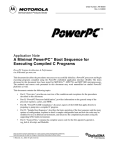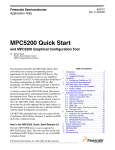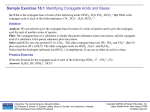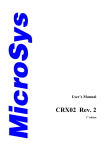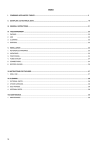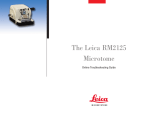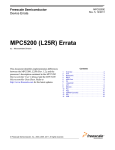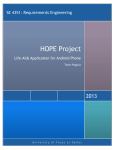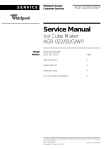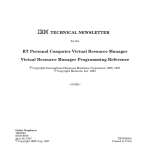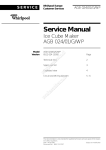Download AN2551, MPC5200 Startup Code
Transcript
Freescale Semiconductor Application Note AN2551 Rev. 1, 08/2005 MPC5200 Startup Code by: Mark Jonas 1 Introduction This application note describes the procedures necessary to initialize a MPC5200 processor and to begin executing programs compiled using the Embedded Application Interface (EABI) for PowerPC processors. All source code is target to run on the IceCube+ MPC5200 Evaluation Platform when it is compiled using GNU gcc 2.95.3. However, the source code is written so that it can be ported to any other MPC5200 board with little effort. The boot code presented in this document only does a minimum what is needed to execute a program written according to the EABI specification and is designed to run from system reset. Other exceptions are not handled by the code. Instead, empty handlers are supplied which will prevent the further execution of the program once they are called. If the users whish to add their own exception handling functions this can be done easily in exactly the same way the system reset exception handler is called. The boot code also demonstrates how to gain basic access to the memory management unit (MMU) of the MPC5200. Access protection via block address © Freescale Semiconductor, Inc., 2005. All rights reserved. Table of Contents 1 Introduction . . . . . . . . . . . . . . . . . . . . . . . . . . . . . . . .1 2 MPC5200 Initialization . . . . . . . . . . . . . . . . . . . . . . . .2 2.1 2.2 2.3 2.4 2.5 General Initialization . . . . . . . . . . . . . . . . . . . . . .2 SDRAM Controller . . . . . . . . . . . . . . . . . . . . . . . .2 Memory Management Unit . . . . . . . . . . . . . . . . .3 Caches. . . . . . . . . . . . . . . . . . . . . . . . . . . . . . . . .3 EABI Register Initialization . . . . . . . . . . . . . . . . .4 3 PowerPC EABI Compliance . . . . . . . . . . . . . . . . . . . .4 4 Sample Boot Code . . . . . . . . . . . . . . . . . . . . . . . . . . .5 4.1 4.2 4.3 4.4 4.5 4.6 Configurable Options . . . . . . . . . . . . . . . . . . . . . .6 General Initialization . . . . . . . . . . . . . . . . . . . . . .7 EABI Register Initialization . . . . . . . . . . . . . . . . .9 Moving from ROM to RAM. . . . . . . . . . . . . . . . . .9 GCC Compilation and Linking . . . . . . . . . . . . . . .9 Example User Program . . . . . . . . . . . . . . . . . . .10 5 Source Code . . . . . . . . . . . . . . . . . . . . . . . . . . . . . .10 6 Literature . . . . . . . . . . . . . . . . . . . . . . . . . . . . . . . . .11 MPC5200 Initialization translation (BAT) as well as the usage of data and instruction cache are demonstrated. More advanced features of the MMU which provide support for paging and segmentation are not utilized. Before starting the EABI user program the boot code copies the code and data of the program from ROM to RAM and calls the main () function of the user program. An example user program is supplied which demonstrates C level access of MPC5200 peripherals. This application note is based on the application note A Minimal PowerPC Boot Sequence for Executing Compiled C Programs (AN1809/D). 2 MPC5200 Initialization 2.1 General Initialization Like most other PowerPC processor MPC5200 is at power up in a minimal state with most features, such as caching and address translation, disabled. External interrupts, the machine check exception, floating point exceptions and the time base registers (DEC, TBU and TBL) are also disabled. The exception prefix is configured by the Reset Configuration Word. If this application note speaks about “boot low” the exception prefix is set to 0x0000_0000. 0xFFF0_0000 means “boot high”. This means upon system reset (exception vector 0x0100) the processor executes code beginning at 0x0000_0100 (boot low) or 0xFFF0_0100 (boot high). The code located at the system reset vector must handle system initialization. Exceptions for PowerPC processors are located at increments of 0x0100 from the vector table start address. Because of this the initialization code must fit in such a slot of 256 bytes (64 PowerPC instructions). As the boot code presented here does not fit in this slot the system reset code branches to an address located beyond the end of the exception table’s allocated space. 0x3000 bytes (12 kilobytes) are reserved for the exception vector table. The only chip select active at power up is CSBoot. Depending on the configuration of the exception prefix it is set to start from 0x0000_0000 or 0xFFF0_0000. In both cases it covers 512 kilobytes. To unify the the two cases the boot code sets up CS0 to map the address range from 0xFF80_0000 to 0xFFFF_FFFF, moves execution to this range and disables CSBoot. Anyhow, CSBoot and CS0 share the same physical chip select pin. 2.2 SDRAM Controller When initializing the SDRAM Controller the following sequence is suggested: • If SDRAM CS1 is used, configure GPIO Port Configuration Register (GPS peripheral) accordingly • Set up SDRAM CS0 and CS1 (MM peripheral) • Configure SDRAM Controller (SDRAM peripheral) • Write tap delay to Power On Reset Configuration Register (CDM peripheral) MPC5200 Startup Code, Rev. 1 2 Freescale Semiconductor MPC5200 Initialization Details can be found in the source code accompanying this application note and the MPC5200 User Manual [1]. 2.3 Memory Management Unit The boot code sets up the MMU if memory management is required. Using the MMU to translate memory addresses allows the programmer to specify protection and access control for individual regions of memory. For a minimal system with eight or fewer memory regions, it is sufficient to use block address translation (BAT) to perform rudimentary mapping. For more complex systems, the segment registers and page tables need to be initialized. This application note only addresses the minimal configuration using the BAT registers. For documentation about using BAT registers and the MMU, refer to Programming Environments Manual for 32-Bit Implementations of the PowerPC Architecture (MPCFPE32B/AD) [2] and G2 Core Reference Manual (G2CORERM/D) [3]. When using the MMU to provide address translation via the BAT registers, each region of memory in the system should have an associated BAT mapping. These mappings allow the programmer to specify options such as whether the specified address range is valid for supervisor or user mode, the memory/cache access mode and the protection bits for the block. There are sixteen BAT array entries. Eight of these map data regions (DBATs), while the remaining eight entries specify instruction regions (IBATs). See [2] for details on using the BAT registers. In a complete operating system, MMU setup continues with invalidating TLB entries, initializing the segment registers and setting up the page table. Even if only BAT mappings are used for translation it is possible that a user program may generate accesses to addresses that are invalid or not mapped by the BAT registers. In this case the processor attempts to look at the page table to resolve the reference. If the page table pointer and entries have not been initialized it is possible that they may contain random data and cause unintended memory accesses. When the MMU setup completes, the MMU may be enabled by setting MSR bits 26 and 27, Instruction Address Translation (IR) and Data Address Translation (DR). At this point address translation is active. 2.4 Caches At power-up instruction and data caches are disabled. These should be turned on to boost program performance. To turn on the instruction cache set bit 16, Instruction Cache Enable (ICE), in the Hardware Implementation Register 0 (HID0). Data cache is enabled by setting bit 17, Data Cache Enable (DCE), in the same register. An isync instruction should be issued before setting the ICE bit to ensure that the cache is not enabled or disabled during an instruction fetch. Similarly, a sync instruction should be executed before setting the DCE bit. Memory regions that represent processor internal or external peripherals should not be cached. Else, it is possible that values written to these regions are not written immediately when using copy back caching or that changes in the hardware are not reflected in the values read from the cache. Therefore, the caches should be disabled whenever the MMU is disabled. Note that simply enabling the caches is not sufficient to ensure that the caches will be used if the MMU is enabled. Memory regions where the user data resides should be mapped as non-cache-inhibited in order MPC5200 Startup Code, Rev. 1 Freescale Semiconductor 3 PowerPC EABI Compliance to make use of the cache. See Section 2.3, Memory Management Unit for more information on mapping memory regions. 2.5 EABI Register Initialization In order for user applications to run correctly, registers specified by the Embedded Application Binary Interface (EABI) must be set up. This is handled by the __eabi() startup code and the code that executes prior to entry into main(). The sample boot code provides a simple __eabi() function that initializes registers GPR2 and GPR13. GPR1 is initialized prior to the call to main() by the initialization sequence. Section 3, PowerPC EABI Compliance describes these registers and the other EABI register conventions in more detail. 3 PowerPC EABI Compliance The PowerPC EABI specifies the system interface for compiled programs. The EABI is based on the System V Application Binary Interface [4] and the PowerPC Processor Supplement [5]. For general ABI documentation, refer to these documents, as well as the PowerPC Embedded Application Binary Interface [6]. This application note only includes aspects of the EABI that apply directly to preparing to jump into a compiled C program. For running compiled programs, the EABI-specified register conventions must be followed. The EABI defines how the processor’s registers are to be used by a conforming application. Table 1 lists the register conventions for the PowerPC EABI. Table 1. PowerPC EABI Registers Register Type Contents GPR0 Volatile GPR1 Dedicated Stack Frame Pointer (SP) GPR2 Dedicated Read-only small data anchor (_SDA2_BASE) GPR3 - GPR4 Volatile Parameter passing / return values GPR5 - GPR10 Volatile Parameter passing GPR11 - GPR12 Volatile GPR13 Dedicated GPR14 - GPR31 Nonvolatile FPR0 Volatile Language specific FPR1 Volatile Parameter passing / return values FPR2- FPR8 Volatile Parameter passing FPR9 - FPR13 Volatile Language specific Read-write small data anchor (_SDA_BASE) MPC5200 Startup Code, Rev. 1 4 Freescale Semiconductor Sample Boot Code Table 1. PowerPC EABI Registers (continued) Register Type FPR14 - FPR31 Nonvolatile Fields CR2 - CR4 Nonvolatile Other CR fields Volatile Other registers Volatile Contents The symbols _SDA_BASE and _SDA2_BASE are defined during linking. They specify the locations of the small data areas (read-write and read-only). A program must load these values into GPR13 and GPR2, respectively, before accessing program data. The small data areas contain part of the data of the executable. They hold a number of variables that can be accessed within a 16-bit signed offset of _SDA_BASE or _SDA2_BASE. References to these variables are performed through references to GPR13 and GPR2 by the user program. Typically, the small data areas contain program variables that are less than or equal to 8 bytes in size, although this differs by compiler and is usually adjustable, too. Before executing user code, the startup code must also set up the stack pointer in GPR1. This pointer must be 8-byte aligned for the EABI (as opposed to 16-byte aligned for the PowerPC ABI) and should point to the lowest allocated valid stack frame. The stack grows toward lower addresses, so its location should be selected so that it does not grow into text, data or bss areas. Much of the required EABI register setup is accomplished through a call to __eabi(). The user does not call this function directly. Instead, the compiler inserts the call to __eabi() at the beginning of main() in the user program. Most compile environments provide an __eabi() function that is automatically linked with user programs. Unfortunately, this standard __eabi() is often designed to work with a particular operating system or environment. Because the processor is using the source in this application note, a minimal __eabi() function is supplied to handle these specific requirements. The remainder of the registers are listed for completeness and are not modified by the minimal boot code. They may be modified by the user program. 4 Sample Boot Code The sample boot code that accompanies this application note performs a minimal processor setup, chip select configuration and SDRAM controller initialization and executes a user program. Other peripherals are not initialized and external and critical interrupts are left disabled. It is designed for use with the IceCube+ MPC5200 Evaluation Platform and was tested using GNU gcc 2.95.3 and GNU binutils 2.11.92. This code sequence is designed to take the place of the traditional crt0 module, as well as to provide hardware initialization normally performed by operating the system. The basic operation of the boot sequence is as follows: 1. Invalidate BAT entries. 2. Set up BAT registers to provide address translation and protection. 3. Invalidate TLB entries. MPC5200 Startup Code, Rev. 1 Freescale Semiconductor 5 Sample Boot Code 4. Turn on address translation. 5. Set up SDRAM controller. 6. Relocate the text, data and bss sections from ROM to RAM. 7. Enable caches. 8. Place the user code main() entry address in SSR0 9. Put the MSR value for the user program into SRR1. 10. Save the return address in the link register. 11. Set up a stack pointer in GPR1 for the user program. 12. Execute rfi. This executes the user program by jumping to the address stored in SRR0. Before running the user code, a compiler-inserted call to __eabi() sets up EABI registers GPR2 and GPR13. 13. Perform an endless loop in case the user program exits. This procedure may be modified or configured to match the desired configuration. 4.1 Configurable Options The design of the boot code allows it to be easily configurable. The many options defined in the header file init.h allow the user to choose how the code should execute. These option are summarized in Table 2. Table 2. User-Configurable Program Options Option MMU_ON Definition Specifies whether or not to use the MMU. 1 = MMU on 0 = MMU off ICACHE_ON Specifies whether to turn on the instruction cache. 1 = icache on 0 = icache off DCACHE_ON Specifies whether to turn on the data cache. 1 = dcache on 0 = dcache off DDR EMODE MODE Specifies the kind of SDRAM used. 1= DDR 0= SDR Value to write to the Extended Mode Register of the DDR SDRAM chip(s) during initialization of the SDRAM controller. Value to write to the Mode Register of the SDRAM chip(s) during initialization of the SDRAM controller. CONTROL Value to write to the Control Register of the SDRAM controller. CONFIG1 Value to write to the Config1 Register of the SDRAM controller. CONFIG2 Value to write to the Config2 Register of the SDRAM controller. TAP_DEL Tap Delay to be used when accessing SDRAM. RAM_START RAM_SIZE Start address of the SDRAM. Should be 0x0000_0000 for this boot code. Size of SDRAM in MPC5200 SDRAM Chip Select notation. See [1], Memory Map chapter. MPC5200 Startup Code, Rev. 1 6 Freescale Semiconductor Sample Boot Code Table 2. User-Configurable Program Options (continued) Option Definition FLASH_START Flash memory range start address. Should be 0xFF80_0000 for the IceCube+ board. FLASH_STOP Flash memory range stop address. Should be 0xFFFF_FFFF for this boot code. STACK_LOC Initialization value of the stack pointer. Make sure that the stack does not grown into text, data or bss sections. PROM_BASE The start address of the address range corresponding to the physical address of the Flash. PRAM_BASE The start address of the address range corresponding to the physical address of the SDRAM. PMBAR The start address of the address range corresponding to the physical address of the internal peripheral address space. Should be 0x8000_0000 as MBAR is not move by the boot code. VROM_BASE The start address of the address range corresponding to the virtual address of the Flash. VRAM_BASE The start address of the address range corresponding to the virtual address of the SDRAM. VMBAR The start address of the address range corresponding to the virtual address of the internal peripheral address space. IBATxL_VAL Specifies the 32-bit value for the lower BAT register for instruction BAT array entry x (x=0 to 7). IBATxU_VAL Specifies the 32-bit value for the upper BAT register for instruction BAT array entry x (x=0 to 7). DBATxL_VAL Specifies the 32-bit value for the lower BAT register for data BAT array entry x (x=0 to 7). DBATxU_VAL Specifies the 32-bit value for the upper BAT register for data BAT array entry x (x=0 to 7). The locations of the text, data and bss sections are defined in the linker definition script linkerscript.lds. These addresses control the location of the various sections in the compiled program both when programming the image to ROM or when the sections are relocated from ROM to RAM by the boot code. To aid the user in flashing the boot code and the user program easily using the dBUG monitor program the Load Memory Address (LMA) is set to 0x0002_0000 as this is the first address in SDRAM not used by dBUG and is available to the user. The place from where the code is being execute is the Virtual Memory Address (VMA). This is set to 0x0000_0000 for this boot code because SDRAM starts at this address after it is set up. 4.2 General Initialization Processor initialization in the sample boot code follows the steps outlined in Section 2, MPC5200 Initialization. One of the most important tasks of the boot code is to set the value of the MSR for the user program. Specifically, the MSR is set up to enable floating-point and machine check exceptions. The exceptions prefix is set to 0x0000_0000 as the text section including the exception vector table is copied from ROM to RAM and the SDRAM starts at 0x0000_0000. MPC5200 Startup Code, Rev. 1 Freescale Semiconductor 7 Sample Boot Code Boot High 1 2 3 2b 3 CSBoot CS0 SDRAM Boot Low 1 2a Figure 1. Chip Selects During Boot The order in which the chip selects are enabled and disabled during boot is shown in Figure 1. When booting high execution starts at 0xFFF0_0000. Then CS0 is set up and covers the same area CSBoot covers. Then it is enabled and CSBoot is disabled in the same moment. Boot low is a little bit more complicated. CS0 is set up just like when booting low but instead of disabling CSBoot when enabling CS0 it stays active. Before CSBoot can be disabled execution must be moved to the alias address in CS0. When that has been accomplished CSBoot can be deactivated. The caches are invalidated and disabled during the majority of the boot code. This prevents program data from being preloaded into the caches, which would unfairly speed up a benchmark. Before branching into the user program the boot code enables instruction and data caches if ICACHE_ON and DCACHE_ON are set to 1 respectively. Finally, if MMU_ON is set to 1, the boot code initializes the BAT registers and enables address translation. MPC5200 Startup Code, Rev. 1 8 Freescale Semiconductor Sample Boot Code 4.3 EABI Register Initialization In order for a C program compiled with an EABI-compliant compiler to execute properly, registers GPR1, GPR2 and GPR13 must be initialized as described in Section 3, PowerPC EABI Compliance GPR1 should be loaded with STACK_LOC, the location of the stack reserved for the user program defined in init.h. Care should be taken to ensure that the stack size is sufficient and that it does not grow into text, data or bss sections of the program during execution. The EABI registers GPR2 and GPR13 are initialized by the __eabi() function. The call to __eabi() is automatically inserted at the beginning of main() by the compiler. It should not be called directly by the user program unless the user does not have a main() function. Programs that lack main() should call __eabi() before executing any user code. 4.4 Moving from ROM to RAM The code relocation depends on the variables that are allocated in the file linkerscript.lds. The text, data and bss sections are copied from ROM to RAM using these variables. The first section that is relocated is the text section. The relocation code looks at the linkerscript.lds variable __text_start and the location of the section in ROM to determine if the text section must be relocated. If the addresses are not the same, the section is relocated. The length of the text section is stored in the variable __text_size. The size of the section must be a multiple of 64 bytes as the copy loop is speed optimized for this. That the size is a multiple of 64 bytes is ensured by linkerscript.lds. The text section is relocated from ROM to RAM to speed up the execution of programs as access to ROM are usually slower than to RAM. Next, the data and bss section are relocated. Their location is also marked by a start address (__data_start, _bss_start) as well as a size in bytes (__data_size, __bss_size), which must be a multiple of 64 bytes again. The data and sections are relocated from ROM to RAM not only to speed up the access to data but also to allow the user code to modify the data. The bss section is not actually copied since it only holds uninitialized data. Instead, the region starting at __bss_start is initialized to all zeroes for __bss_size bytes. This code may be commented out for programs which do not depend on zero-filled bss. Execution from the relocated text section in RAM starts when the boot code jumps to main() using the rfi instruction. 4.5 GCC Compilation and Linking The compilation and linking procedure for a standalone bootable program is fairly complex. The compiled program should not include standard libraries or startup code, and needs to be in a format that can be used to program the Flash memory of the board. Most importantly, the code needs to be located at a specific absolute start address so that it begins execution on system reset. In addition, the executable needs to be built so that references to symbols and variables refer to the location of variables after the relocation to RAM has occurred. Most of this work is accomplished through the use of a linker script. MPC5200 Startup Code, Rev. 1 Freescale Semiconductor 9 Source Code The compilation procedure described here uses GNU gcc 2.95.3 and GNU binutils 2.11.92 which are free and publicly available from many different source on the Internet. The GNU make utility is also used. The file Makefile is the makefile for the boot code and an example user program. It is written in a quite flexible way so that source files can be added or removed easily by editing the makefile variable SRCS. Dependencies between the source files and their includes are maintained using an automatically generated dependency file depend. The tools needed for compilation, linking and object file maintenance must be passed through the variables CC, LD, OC, MKDEP and RM. CC defines the C compiler (default ’powerpc-eabi-gcc’), LD defines the linker (default ’powerpc-eabi-ld’), OC a program to convert one object file format into another (default ’powerpc-eabi-objcopy’), MKDEP the dependency file generator (default ’powerpc-eabi-gcc -MM’) and RM a program to delete files (default ’rm -rf’). When using the default target the makefile will generate four main output files. mpc5200startup.elf is an image of the compiled program in ELF format. mpc5200startup.mot and mpc5200startup.bin represent the same image but in S-Record and Binary format respectively. Additionally, mpc5200startup.map is a map file showing the symbols and their location in the image. The linker script linkerscript.lds controls how the GNU linker will put together the object files the project consists of in one executable image. The linker script groups together the various segments (.text, .rodata, .data, .sdata, .sdata2, .bss, .sbss, ...) generated by the compiler into sections which are then arranged in the LMA and VMA memory map, see Section 4.2, General Initialization. 4.6 Example User Program All source files (*.S, *.c, *.h) except vectors.S, init.S, init.h and reg_defs.h belong to the example user program. The user program implements a Sieve of Erastostenes benchmark timing how long it takes to find all primes between 0 and 100000. To print its results the program initializes PSC1 to UART mode at 115200 Baud, 8N1. To measure the time elapsed while the program calculated the primes the core’s time base registers TBU and TBL are used. The program can be used to experiment with the various cache and MMU settings as well as a basis for own benchmarks. Of course, it can be used as an example for programming any other kind of application as well. 5 Source Code The source code accompanying this application note is not printed here because it would span to many pages. It can be downloaded from the same place on the Freescale Semiconductor, Inc. (formerly Motorola) web page where this application note was found. MPC5200 Startup Code, Rev. 1 10 Freescale Semiconductor Literature 6 Literature [1] MPC5200 User Manual ( Freescale [formerly Motorola]) [2] Programming Environments Manual for 32-Bit Implementations of the PowerPC Architecture ( Freescale [formerly Motorola], MPCFPE32B/AD) [3] G2 Core Reference Manual (Freescale [formerly Motorola], G2CORERM/D) [4] System V Application Binary Interface [5] PowerPC Processor Supplement [6] PowerPC Embedded Application Binary Interface [7] Developing PowerPC Embedded Application Binary Interface (EABI) Compliant Programs (IBM) [8] A Minimal PowerPC Boot Sequence for Executing Compiled C Programs (AN1809/D) MPC5200 Startup Code, Rev. 1 Freescale Semiconductor 11 How to Reach Us: Home Page: www.freescale.com E-mail: [email protected] USA/Europe or Locations Not Listed: Freescale Semiconductor Technical Information Center, CH370 1300 N. Alma School Road Chandler, Arizona 85224 +1-800-521-6274 or +1-480-768-2130 [email protected] Europe, Middle East, and Africa: Freescale Halbleiter Deutschland GmbH Technical Information Center Schatzbogen 7 81829 Muenchen, Germany +44 1296 380 456 (English) +46 8 52200080 (English) +49 89 92103 559 (German) +33 1 69 35 48 48 (French) [email protected] Japan: Freescale Semiconductor Japan Ltd. Headquarters ARCO Tower 15F 1-8-1, Shimo-Meguro, Meguro-ku, Tokyo 153-0064 Japan 0120 191014 or +81 3 5437 9125 [email protected] Asia/Pacific: Freescale Semiconductor Hong Kong Ltd. Technical Information Center 2 Dai King Street Tai Po Industrial Estate Tai Po, N.T., Hong Kong +800 2666 8080 [email protected] For Literature Requests Only: Freescale Semiconductor Literature Distribution Center P.O. Box 5405 Denver, Colorado 80217 1-800-441-2447 or 303-675-2140 Fax: 303-675-2150 [email protected] AN2551 Rev. 1, 08/2005 Information in this document is provided solely to enable system and software implementers to use Freescale Semiconductor products. There are no express or implied copyright licenses granted hereunder to design or fabricate any integrated circuits or integrated circuits based on the information in this document. Freescale Semiconductor reserves the right to make changes without further notice to any products herein. Freescale Semiconductor makes no warranty, representation or guarantee regarding the suitability of its products for any particular purpose, nor does Freescale Semiconductor assume any liability arising out of the application or use of any product or circuit, and specifically disclaims any and all liability, including without limitation consequential or incidental damages. “Typical” parameters that may be provided in Freescale Semiconductor data sheets and/or specifications can and do vary in different applications and actual performance may vary over time. All operating parameters, including “Typicals”, must be validated for each customer application by customer’s technical experts. Freescale Semiconductor does not convey any license under its patent rights nor the rights of others. Freescale Semiconductor products are not designed, intended, or authorized for use as components in systems intended for surgical implant into the body, or other applications intended to support or sustain life, or for any other application in which the failure of the Freescale Semiconductor product could create a situation where personal injury or death may occur. Should Buyer purchase or use Freescale Semiconductor products for any such unintended or unauthorized application, Buyer shall indemnify and hold Freescale Semiconductor and its officers, employees, subsidiaries, affiliates, and distributors harmless against all claims, costs, damages, and expenses, and reasonable attorney fees arising out of, directly or indirectly, any claim of personal injury or death associated with such unintended or unauthorized use, even if such claim alleges that Freescale Semiconductor was negligent regarding the design or manufacture of the part. Freescale™ and the Freescale logo are trademarks of Freescale Semiconductor, Inc. All other product or service names are the property of their respective owners. © Freescale Semiconductor, Inc. 2004, 2005. All rights reserved.













